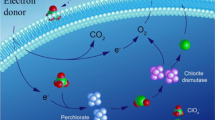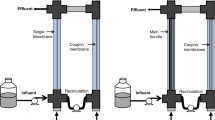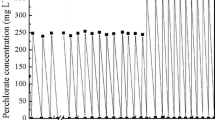Abstract
A novel isolated bacterium Rhodococcus sp. YSPW03 was able to reduce high concentrations (up to 700 mg L−1) of perchlorate using acetate as electron donor. Perchlorate reduction rate increased from 2.90 to 11.23 mg L−1 h−1 with increasing initial acetate concentration from 100 to 2000 mg L−1, leading to complete removal of perchlorate (100 mg L−1) within 9 h. The bacterium also promoted complete reduction of high perchlorate concentrations (500 and 700 mg L−1) at 2000 mg L−1 of acetate within 48 and 96 h, respectively. Under semi-continuous reactor operation, efficient reduction on varied perchlorate concentrations (80–700 mg L−1) was performed by the bacterium in presence of acetate (600–6000 mg L−1) over 140 days. The highest perchlorate reduction rate of 280 mg L−1 day−1 was observed with an initial perchlorate concentration of 570 mg L−1 at day 34. Dissolved chloride ions of 1000 mg L−1 in the semi-continuous reactor (SCR) completely inhibited the biological perchlorate reduction. The findings of this study will help improve the perchlorate bioreactor design and determine the optimal conditions to maximize the perchlorate reduction efficiency.



Similar content being viewed by others
References
Attaway H, Smith M (1993) Reduction of perchlorate by an anaerobic enrichment culture. J Ind Microbiol 12:408–412
Bruce RA, Achenbach LA, Coates JD (1999) Reduction of (per)chlorate by a novel organism isolated from paper mill waste. Environ Microbiol 1:319–329
Coates JD, Michaelidou U, Bruce RA, O’Connor SM, Crespi JN, Achenbach LA (1999) Ubiquity and diversity of dissimilatory (per)chlorate-reducing bacteria. Appl Environ Microbiol 65:5234–5241
Dudley M, Salamone A, Nerenberg R (2008) Kinetics of a chlorate-accumulating, perchlorate-reducing bacterium. Water Res 42:2403–2410
Felsenstein J (1985) Confidence limits on phylogenies: an approach using the bootstrap. Evolution 39:783–791
Gu B, Brown GM, Chiang CC (2007) Treatment of perchlorate-contaminated groundwater using highly selective, regenerate ion-exchange technologies. Environ Sci Technol 41:6277–6282
Hatzinger PB (2005) Perchlorate biodegradation for water treatment. Environ Sci Technol 39:239A–247A
Hatzinger PB, Whittier MC, Arkins MD, Bryan CW, Guarini WJ (2002) In-situ and Ex-situ bioremediation options for treating perchlorate in groundwater. Remediation 12:69–86. doi:10.1002/rem.10026
Jukes TH, Cantor CR (1969) Evolution of Protein Molecules. In: Munro HN (ed) Mammalian Protein Metabolism. Academic Press, pp 21–132
Kim K, Logan BE (2001) Microbial reduction of perchlorate in pure and mixed culture packed-bed bioreactors. Water Res 35:3071–3076
Kumar E et al (2010) Perchlorate removal from aqueous solutions by granular ferric hydroxide (GFH). Chem Eng J 159:84–90
Lakshmi J, Vasudevan S (2013) Graphene—a promising material for removal of perchlorate (ClO4 −) from water. Environ Sci Pollut Res 20:5114–5124
Logan BE (1998) A review of chlorate- and perchlorate-respiring microorganisms. Biorem J 2:69–79
Logan BE (2001) Assessing the outlook for perchlorate remediation. Environ Sci Technol 35:482A–487A
Logan BE, Zhang H, Mulvaney P, Milner MG, Head IM, Unz RF (2001) Kinetics of perchlorate- and chlorate-respiring bacteria. Appl Environ Microbiol 67:2499–2506
Maidak BL et al (2001) The RDP-II (Ribosomal Database Project). Nucleic Acids Res 29:173–174
Marchesi JR, Sato T, Weightman AJ, Martin TA, Fry JC, Hiom SJ, Wade WG (1998) Design and evaluation of useful bacterium-specific PCR primers that amplify genes coding for bacterial 16S rRNA. Appl Environ Microbiol 64:795–799
Nerenberg R, Kawagoshi Y, Rittmann BE (2006) Kinetics of a hydrogen-oxidizing, perchlorate-reducing bacterium. Water Res 40:3290–3296
Niu Q, Qiao W, Qiang H, Hojo T, Li Y-Y (2013) Mesophilic methane fermentation of chicken manure at a wide range of ammonia concentration: Stability, inhibition and recovery. Bioresour Technol 137:358–367
Nor SJ, Lee SH, Cho KS, Cha DK, Lee KI, Ryu HW (2011) Microbial treatment of high-strength perchlorate wastewater. Bioresour Technol 102:835–841
Okeke BC, Giblin T, Frankenberger WT Jr (2002) Reduction of perchlorate and nitrate by salt tolerant bacteria. Environ Pollut 118:357–363
Oosterkamp MJ, Mehboob F, Schraa G, Plugge CM, Stams AJ (2011) Nitrate and (per)chlorate reduction pathways in (per)chlorate-reducing bacteria. Biochem Soc Trans 39:230–235
Patel A, Zuo G, Lehman SG, Badruzzaman M, Clifford DA, Roberts DJ (2008) Fluidized bed reactor for the biological treatment of ion-exchange brine containing perchlorate and nitrate. Water Res 42:4291–4298
Rikken GB, Kroon AGM, Van Ginkel CG (1996) Transformation of (per)chlorate into chloride by a newly isolated bacterium: Reduction and dismutation. Appl Microbiol Biotechnol 45:420–426
Rittmann BE, McCarty PL (2001) Environmental biotechnology: principles and application. McGraw-Hill Book Company, New York
Roquebert V, Booth S, Cushing RS, Crozes G, Hansen E (2000) Electrodialysis reversal (EDR) and ion exchange as polishing treatment for perchlorate treatment. Desalination 131:285–291
Rusanova MY, Polášková P, Muzikař M, Fawcett WR (2006) Electrochemical reduction of perchlorate ions on platinum-activated nickel. Electrochim Acta 51:3097–3101
Saitou N, Nei M (1987) The neighbor-joining method: a new method for reconstructing phylogenetic trees. Mol Biol Evol 4:406–425
Shrout JD, Parkin GF (2006) Influence of electron donor, oxygen, and redox potential on bacterial perchlorate degradation. Water Res 40:1191–1199
Stroo HF, Ward CH (2009) In Situ Bioremediation of Perchlorate in Groundwater. SERDP ESTCP Environmental Remediation Technology. Springer-Verlag New York
Thrash JC, Ahmadi S, Torok T, Coates JD (2010) Magnetospirillum bellicus sp. nov., a novel dissimilatory perchlorate-reducing alphaproteobacterium isolated from a bioelectrical reactor. Appl Environ Microbiol 76:4730–4737
Urbansky ET (2002) Perchlorate as an environmental contaminant. Environ Sci Pollut Res 9:187–192
US EPA (1993) Determination of Inorganic anions by Ion chromatography 600/4-79-020, US
US EPA (1999) Determination of Perchlorate in Drinking water using Ion Chromatography 815/R-00-014, US
US EPA (2005) Perchlorate treatment technology update: federal facilities forum issue paper 542/R-05-015, US
Waller AS, Cox EE, Edwards EA (2004) Perchlorate-reducing microorganisms isolated from contaminated sites. Environ Microbiol 6:517–527
Wang C, Lippincott L, Meng X (2008) Kinetics of biological perchlorate reduction and pH effect. J Hazard Mater 153:663–669
Wu J, Unz RF, Zhang H, Logan BE (2001) Persistence of perchlorate and the relative numbers of perchlorate- and chlorate-respiring microorganisms in natural waters, soils, and wastewater. Biorem J 5:119–130
Zhang H, Bruns MA, Logan BE (2002) Perchlorate reduction by a novel chemolithoautotrophic, hydrogen-oxidizing bacterium. Environ Microbiol 4:570–576
Acknowledgments
This work was supported by the Mid-career Researcher Program (National Research Foundation of Korea, 2013069183) of the Korea Ministry of Education Science & Technology (MEST) and Ansan Green Environmental Center (AGEC) funded by Ministry of Environment, Republic of Korea.
Author information
Authors and Affiliations
Corresponding author
Additional information
Responsible editor: Bingcai Pan
Rights and permissions
About this article
Cite this article
Lee, SH., Hwang, JH., Kabra, A.N. et al. Perchlorate reduction from a highly concentrated aqueous solution by bacterium Rhodococcus sp. YSPW03. Environ Sci Pollut Res 22, 18839–18848 (2015). https://doi.org/10.1007/s11356-015-5072-8
Received:
Accepted:
Published:
Issue Date:
DOI: https://doi.org/10.1007/s11356-015-5072-8




